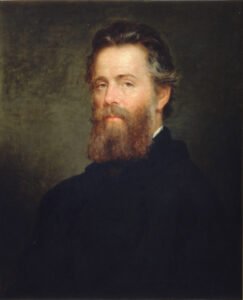Books By Herman Melville
- Typee: A Peep at Polynesian Life (1846) – Marquesas series
- Omoo: A Narrative of Adventures in the South Seas (1847) – Marquesas series
- Mardi, and a Voyage Thither (1849) – standalone
- Redburn: His First Voyage (1849) – standalone
- White-Jacket; or, The World in a Man-of-War (1850) – standalone
- Moby-Dick; or, The Whale (1851) – standalone
- Pierre; or, The Ambiguities (1852) – standalone
- Israel Potter: His Fifty Years of Exile (1855) – standalone
- The Piazza Tales (1856) – collection of short stories
- The Confidence-Man: His Masquerade (1857) – standalone
- Battle-Pieces and Aspects of the War (1866) – poetry collection
- Clarel: A Poem and Pilgrimage in the Holy Land (1876) – poetry collection
- John Marr and Other Sailors (1888) – poetry collection
- Timoleon (1891) – poetry collection
- Billy Budd, Sailor (An Inside Narrative) (1924) – standalone
About Herman Melville
 Herman Melville, born on August 1, 1819, in New York City, was an American novelist, poet, and short story writer best known for his masterpiece, “Moby-Dick.” Melville’s literary career spanned the mid-19th century, and though he experienced limited commercial success during his lifetime, his works have since earned him a place among the greatest authors in American literature.
Herman Melville, born on August 1, 1819, in New York City, was an American novelist, poet, and short story writer best known for his masterpiece, “Moby-Dick.” Melville’s literary career spanned the mid-19th century, and though he experienced limited commercial success during his lifetime, his works have since earned him a place among the greatest authors in American literature.
Melville’s early life was marked by hardship and adventure. At the age of 20, he embarked on a whaling voyage aboard the whaler Acushnet, an experience that would inspire much of his later writing. After several years at sea, Melville returned to New York City and began writing novels based on his maritime experiences.
In 1846, Melville published his first novel, “Typee: A Peep at Polynesian Life,” which drew upon his experiences living among the natives of the Marquesas Islands. The novel was a commercial success and established Melville as a promising young author. He followed this with “Omoo” in 1847, further solidifying his reputation as a writer of adventure tales set in exotic locales.
However, it was Melville’s magnum opus, “Moby-Dick; or, The Whale,” published in 1851, that secured his place in literary history. A sprawling epic that delves into themes of obsession, revenge, and the nature of humanity, “Moby-Dick” is widely regarded as one of the greatest American novels ever written. Although it initially received mixed reviews and failed to find commercial success during Melville’s lifetime, it has since been recognized as a masterpiece of world literature.
Despite the commercial failure of “Moby-Dick,” Melville continued to write prolifically, producing a diverse body of work that included novels, short stories, and poetry. His later works, such as “Pierre; or, The Ambiguities” and “The Confidence-Man: His Masquerade,” explored themes of morality, identity, and the human condition with depth and complexity.
After years of relative obscurity, Melville’s literary reputation experienced a revival in the early 20th century, as scholars and critics began to reassess his works and recognize their significance. Today, Herman Melville is celebrated as one of the greatest writers in American literature, his novels and stories studied and cherished for their profound insights into the human psyche and the mysteries of existence.
Melville’s legacy continues to endure, his influence felt not only in literature but also in popular culture, where references to “Moby-Dick” and his other works remain pervasive. His exploration of the depths of human experience and the vastness of the natural world continues to resonate with readers of all ages, ensuring that his place in the pantheon of literary greats will remain secure for generations to come.

